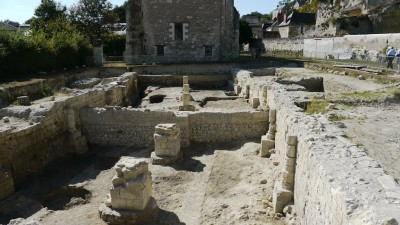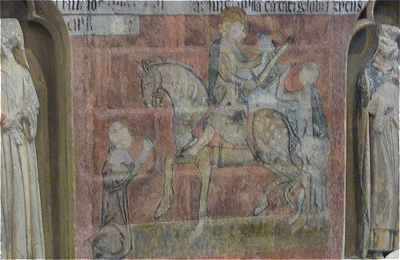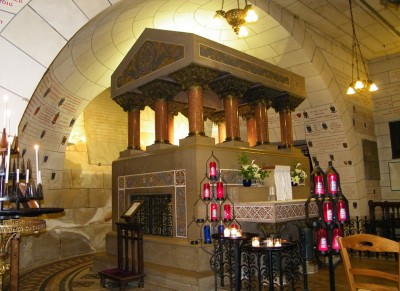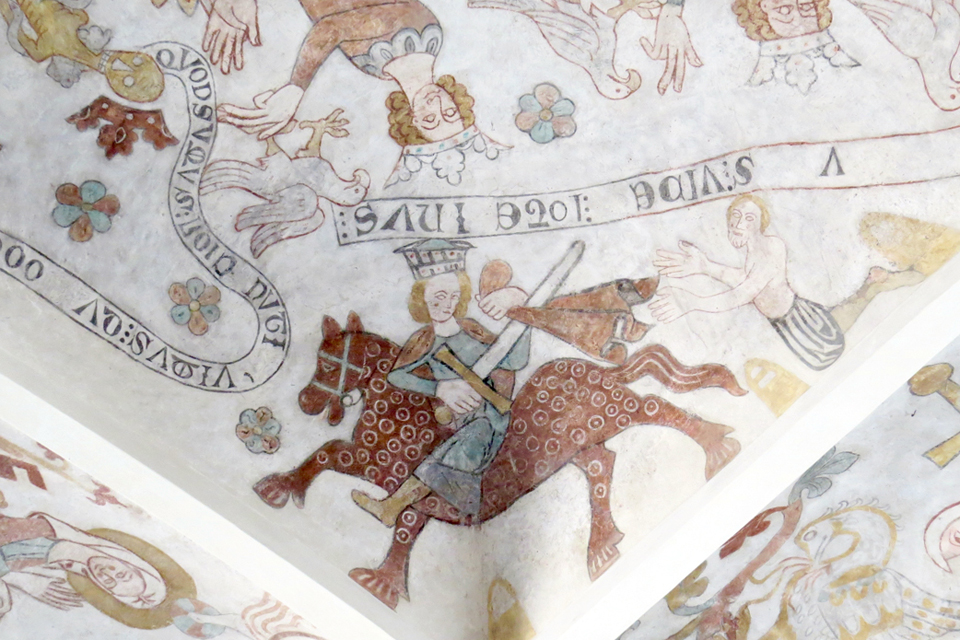Saint Martin was the first non-martyr to be sainted by popular acclamation. Still popular, he succeeded by shift-shaping over the centuries – from 4th-century ascetic to 20th-century conscientious objector.
St. Martin is widely accepted as one of the most important non-biblical and non-martyred saints. It is widely believed that this is a position he achieved early on and has kept since. However the history of the saint – or rather the history of the constant transformations of his cult – tells a somewhat different story.
Short Biography

The bare facts of the history of Martin of Tours are as follows: He is believed to have been born in AD 316 in the city of Savaria in Pannonia (now Szombathely in Hungary). His father was a tribune in the imperial Horse Guard and was as such stationed in Ticinum (now Pavia) Northern Italy. Here Martin of Tours grew up when Christianity was barely an official religion. As the son of a veteran officer, Martin was obliged to join the cavalry. Around AD 334 he was stationed in Amiens in France. This is where he met a naked beggar with whom he shared his cape by cutting it in half. Of course, the beggar turned out to be Jesus. As the story goes, he afterwards decided that his faith hindered his further participation in warfare. Martin was next charged with cowardice and jailed but is told to have volunteered to go unarmed to the front and face the enemy with no more than a lifted cross. As peace broke out he was released from military service. Afterwards, he joined up with Hilary of Poitiers with whom he travelled far and wide through Gaul and Italy. Later he founded an abbey in Ligugé, which has been excavated. These excavations confirm the existence of a very early religious institution set up to cater for hermits. In 371 he was called to be bishop of Tours. There he founded yet another monastery, Marmoutier, located on the northern brink of Loire opposite Tours. He died in 397 in a small village called Candes. Afterwards, his body was brought by river to Tours, where he was buried in the cemetery on the outskirts of the city. Legend has it that the riverbanks blossomed when the boat with his remains floated by. Hence the epithet “St. Martin’s Summer”.
Saint Martin – an Ascetic Bishop
The primary source of St. Martin’s fame is the writings of Sulpicius Severus (AD 363 – 425). He was a Christian lawyer from Aquitaine. As a younger man, he got to know St. Martin, and already during the lifetime of his friend, he began to write his biography to which he later added three epistles and the dialogues.
Recent studies have shown that the picture, which Severus painted of the saint was carefully outlined. Severus wanted to introduce us to a man who was able to live a perfect ascetic life in the manner of the Eastern hermits, while at the same time able to live an active and pastoral life as bishop, busy with eradicating the lingering paganism. His story of Martin is a sketch of a wandering ascetic for whom Tours just happened to be a convenient base for his pastoral work, which was carried out throughout Gaul.
Saint Martin – a Local Saint

Very soon, however, the life of Martin of Tours was rewritten to fit other agendas: foremost the positioning of Martin as a local saint. This change was orchestrated by the following bishops, St Brice (370 – 444) and Perpetuus († 490). The first built a simple oratory, while the latter created a basilica to house the prestigious remains, now being marketed as those of a distinct local saint worthy of a pilgrimage. Later, Gregory of Tours added to this by the positioning of Martin as the premier French saint. According to Gregory, this elevation was instigated by Clovis around 498, after he had evicted the Arian Visigoths from the city of Tours. Afterwards, Clovis crowned the head of the saint with a diadem. Clovis needed the backing of the bishops of Gaul and bought them by honouring their favourite saint. As McKinley writes: “Like any ideological currency, the cult of St. Martin was not unchanging and fixed: it was adapted to different times and different places as needed.” (McKinley 2006:199). Circumstances dictated whether he was considered an ascetic bishop, a missionary example, a local saint or a national icon.
Saint Martin – Royal Icon
However, there the story did not end. During the next centuries, Martin continued to be “framed” anew according to both local and national needs. Paramount instigator of this redefinition was the abbey, which inspired by the Irish Saint, Columbanus, around 650 became a reformed house. Part of this reformation consisted of a monastic strive to evade episcopal interference in the internal affairs of the Abbey. Later Carolingian reforms tried to reinstate episcopal authority as well as renew the order and status of the Abbey of St. Martin by turning it into a college of canons. However, the Carolingians continued to consider St. Martin a national icon on the level with St. Denis. During the early Carolingians, half of the cope – the first “flag” of France – was transferred to Paris. It is a reflection of the powerful status of St. Martin than the competing post-Carolingian kings each adopted their own national saint. For instance, the Ottonians in 10th century Germany adopted St. Maurice d’Agaune, another Roman soldier, who turned Christian.
Powerplay at Tours

The next centuries were marked by a series of Viking attacks, which severely disrupted life along the Loire as well as in the cities, among those Tours. One such raid from 903 merited a detailed account by Radbod of Utrecht, who was probably at that time a monk at St. Martin. He told the story of how the monks took refuge in the walled city and hid the relics in a small church there while the Vikings burned the basilica of St, Martin and 28 other churches in the Western district of the city. According to Odo of Cluny, who recalled the events in a famous sermon “De Combustione”, God intended to punish the monks at Tours for their luxurious lifestyle. After this catastrophe the area around St. Martin was walled. This merited a new name, “Chateuneuf” as well as set the scene for further divisions between the two parts of the city. Fomented by the decline of the Carolingians and the rise of the week Capetians, this later led to a marked strengthening of the lordships of Anjou and Blois. While the position as lay abbot continued to be reserved for the king of France, the dean and treasurer were now ‘fideles’ of the two counts
The ascendency of these powerful princely families coincided not only with a week king but also a growing papal monarchy.
It was during this period that a peculiar liturgical fight broke out between the bishops of Tours and the Canons at each end of the city; this liturgical powerplay reflected the shifting policies of the monarchy, the different counts and their entourages as well as the popes. Beneath this bitter conflict was the question as to who had the control over the lucrative business of pilgrimage, the adjoining markets and the perambulating royal law-court, which after 1200 used to hold sessions in Tours twice a year. After 1400 both parts of the city were walled and the conflict over the control of the cult of St. Martin seems to have petered out. However, even today it is easy to recognize that the city of Tours is divided between a sleepy “secular” district in the east and a thriving commercial part in the west.
Saint Martin – a Medieval Knight and a Conscientous Objector
It was in the later Middle Ages that St. Martin once more shifted and transformed into the medieval knight par excellence. Together with St. George, St. Maurice and St. Michael he became spokesman for the chivalric ethos during the crusading years. By the 14th century he was thus no longer just soldier, monk, bishop and evangelist. Foremost he was a chivalric knight – a miles Christi – of great prowess. It was this role, which the neo-medievalists in the catholic church in the 19th century assigned to him when they needed a powerful icon their fight for a return to pre-revolutionary France.
Curiously enough, the Protestants finally turned St. Martin into the first conscientious objector. As such he became the silent hero for the Mennonites and Quakers. In the end, his role as peacemaker was confirmed on St. Martin’s Day in 1918, when the armistice took effect at “the eleventh hour of the eleventh day of the eleventh month”.
A Man of All Times
The story of how the foremost French saint was “framed” liturgically and musically by different institutions – royals, lords, canons, bishop – through the early and high middle ages has recently been told by Youssi Maurey, who has worked his way through the (still) impressive remains of liturgical handbooks preserved in the local library in Tours. One key discovery has been a set of distinct liturgies developed by the canons and used to confirm their monopoly: the proper celebration of St. Martin in his hometown, thus laying the “local foundation of a universal saint”. In this work he has been substantially inspired by the earlier work of Sharon Farmer on the “Communities of St. Martin” from 1991.
READ MORE:
Communities of St. Martin. Legend and Ritual in Medieval Tours
By Sharon Farmer
Ithaca and London, Cornell University Press 1991
ISBN-10: 0801423910
ISBN-13: 978-0801423918
Medieval Music, Legend, and the Cult of St Martin: The Local Foundations of a Universal Saint
By Yossi Maurey
Cambridge University Press 2014
ISBN-10: 1107060958
ISBN-13: 978-1107060951
The First Two Centuries of Saint Martin of Tours.
By Allan Scott McKinley
In: Early Medieval Europe 2006, Vol. 14 No. 2, pp.173 – 200
READ ALSO:
Martinmass – A European Festival


